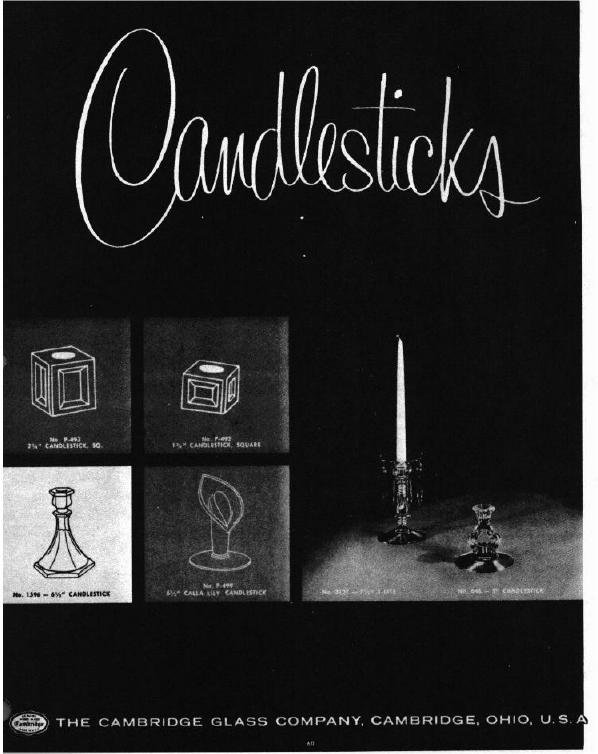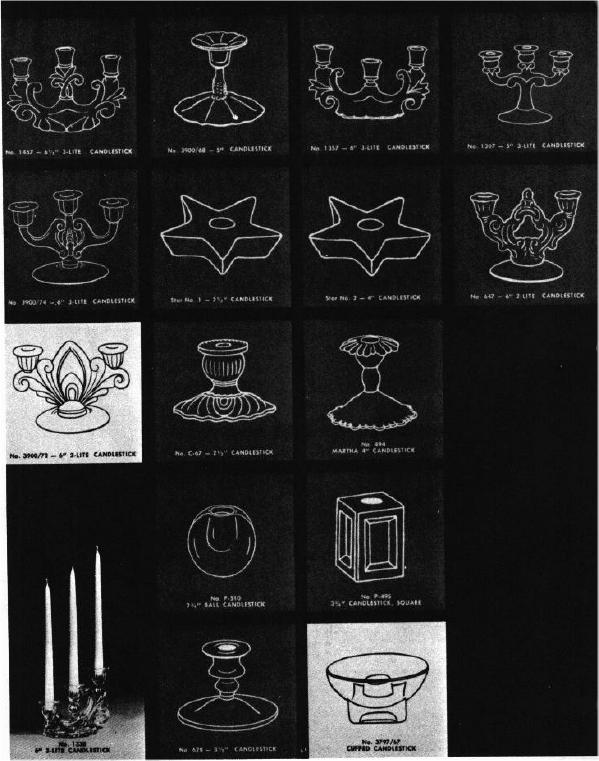Candlesticks, Part II
by Mark A. Nye
Issue No. 215 - March 1991
From the 1920s of Part I, we skip to 1956 for Part II of this series on Cambridge candlesticks. Future articles will cover that 36 year period, but for now we turn our attention to what is sometimes referred to as the "reopen years." In late 1956 the reorganized Cambridge Glass Company issued its first and only catalog and pages 60 & 61 (found at end of article) were devoted to illustrating candlesticks.
Actually, one of the items shown on page 60 is more correctly called a candelabra since it has a bobeche and prisms, this being the familiar #3121 stem enlarged to candlestick size. All told, 22 pieces are illustrated on these two pages, including three sizes of the Pristine square candleholders and two sizes of stars.
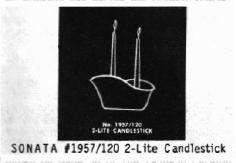 Not found on the two Catalog pages is the Sonata line candlestick, the
only candlestick to be brought out during the reopen years (shown at left).
Not found on the two Catalog pages is the Sonata line candlestick, the
only candlestick to be brought out during the reopen years (shown at left).
Four additional pages are devoted to showing candelabra and epergnes and since such items are based on candlesticks they will be included, where appropriate, in this and future articles.
The Pristine square candlesticks, #492, #493 and #495, were a part of the Pristine line when it was brought out in the late 1930s. Pictured in the 1940 catalog, they were available in a choice of colors, as long as your choice was crystal! Offered only in crystal, they were listed as being available "Sq. Cut Top and Bottom" or "Sq. Full Cut." Six years later the January 1946 price list again offered these candleholders but only with "Square Cut Top and Bottom." The price for the smaller of the three (#492) had risen from $7.50 to $9.40 per dozen. By 1949, the retail price for this candleholder had risen to $12 per dozen, and all three were listed as being available in crystal only. September 1950 saw the issuance of a Cambridge price list in which the Pristine #492, #493 and #495 were offered in crystal and ebony, with the price for the smallest now being $14.40 per dozen.
With the introduction of the Cambridge Square line in 1951, these three candleholders also became a part of that line and were listed under both lines - Cambridge Square and Pristine.
By 1953, the ebony version was no longer available; however, the three holders remained a part of both the Cambridge Square and Pristine lines. With the introduction of ebon in early 1954 came the #493 holder in that color and finish. The March 1956 Cambridge price list had all three available, crystal only, ranging in price from $21 per dozen for the smallest, to $30 for the largest (#495). All three sizes remained available throughout the reopen years, either as a part of the Pristine or the Cambridge Square lines.
The #495 candlestick is known to have been etched Rose Point. However, for the time being, this is the only known decoration.
Also illustrated in the 1956-58 catalog is the Pristine #510 2 1/4" single Ball candlestick. The mold for this piece was ordered in December 1940 and was pictured on a supplemental Cambridge catalog page issued August 1, 1942. Whether or not it was in production before the summer is subject to conjecture. Listed in the 1946 supplemental price list, the #510 candlestick was not offered in the June 1949 catalog, but was shown on a supplemental page issued the following August. From then until the final closing, the single Ball candlestick was a part of the Cambridge line. It is doubtful this candlestick was ever made in color or decorated.
While seldom thought of as such, the piece known as the Cambridge Calla Lily candlestick was also a part of the Pristine line, carrying the number P.499. First shown on a supplemental catalog page, probably issued in the summer of 1942 and offered in crystal only, the Calla Lily candlestick continued in the Cambridge line until the final closing. It was also produced, during the early 1950s, in ebony, mandarin gold and dark emerald. Selling for $15 and $24 per dozen in 1946 and 1950 respectively, the last list price (from 1958) for this item was $42 per dozen or $3.50 each. Known to have been, at some point, etched Rose Point, it is possible the Calla Lily candlestick was decorated in other ways as well.
The #646 5" candlestick first appeared on page 3 of the 1930 Cambridge catalog, where it was illustrated, etched Apple Blossom. Sometimes referred to as the single Keyhole candlestick, this item will be found in most of the transparent colors, with notable exception being mocha and pistachio. Also, no listing has been found for its production in mandarin gold and late emerald. The same holds true for the two-lite Keyhole candlestick known as the #647 that was also introduced in 1930. The keyhole in the original #647 had a smooth top, but by 1932 the version with a knob in the center was in production. In addition to the transparent colors, both of these candlesticks will also be found in crown tuscan and windsor blue.
When it comes to decorations, a collector can reasonably expect to find the #646 and #647 candleholders with most, if not all, of the 1930s and 1940s major etchings. In addition to being available plain on crystal and colored blanks, many etchings will also be found on crystal blanks gold encrusted or plain with a gold edge. A few, such as Apple Blossom, were etched on blanks in the darker transparent colors such as amethyst, royal blue and ebony and silver encrusted. The #646 and #647 candlesticks produced in the 1950s, prior to the initial factory shutdown, will be found etched Roselyn, but there is no indication they were etched Magnolia or Daffodil. The last list prices for etched #646 and #647 are $39 and $54 per dozen respectively, as compared to $18 and $30 in 1940.
During the 1930s and 1940s, the #647 was available with numerous Rock Crystal engravings; and one cannot rule out the possibility that the #646 was similarly decorated to some extent.
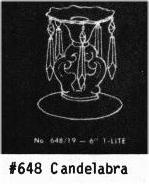 With the addition of a bobeche and eight prisms, the #646 becomes
#648 6" candelabra; and with two bobeches and 16 prisms, the #647 turns
With the addition of a bobeche and eight prisms, the #646 becomes
#648 6" candelabra; and with two bobeches and 16 prisms, the #647 turns
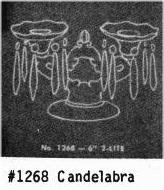 into the #1268 2-lite candelabra. When intended for use with a bobeche
the candle pocket will have two nubs of glass on its rim that serve to
hold the bobeche in place.
into the #1268 2-lite candelabra. When intended for use with a bobeche
the candle pocket will have two nubs of glass on its rim that serve to
hold the bobeche in place.
In 1940, the #648 candelabra was offered with a choice of two different bobeches - the #19 and #23. Candelabra bases were made in less colors that the candlesticks; for instance, the 1940 price list showed the candelabra as being available only in moonlight and crystal, while the candlesticks could have been had in crystal, amber, dianthus, moonlight, forest, royal blue, amethyst and carmen. Many, however, will be found with the same etchings and other decorations as found on the candlesticks. These two items were available from the time they were introduced in the 1930s until the final plant closing.
While not shown in the 1956-1958 Cambridge catalog, or available in the final years, the #646 and #647 candlesticks were, in earlier times, also used in the assembly of epergnes.
The 1940 catalog contained illustrations of two epergnes: the #654 1-lite, with bobeche, eight prisms, one arm and two vases; and the #662 2-lite, with two arms, four vases and no bobeche. These particular epergnes make use of the #1438 arm or arms, vases, and optionally, the #19 bobeche with the #1 2 1/2" prisms.
Epergnes were usually constructed of crystal components since most of the arms, bobeches and epergne vases were made in crystal. On the rare occasion, a moonlight arm, bobeche or vase will be found.
In the 1940 price list, the #654 epergne, in crystal and unetched, was priced at $70 per dozen.
To be continued ...
